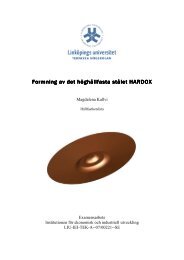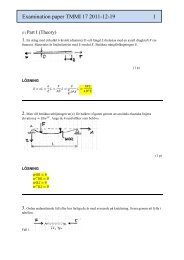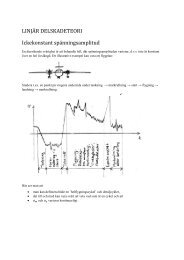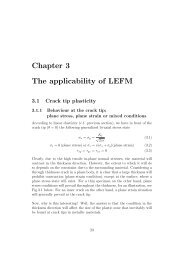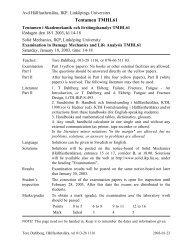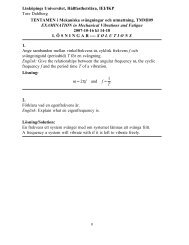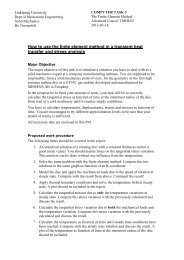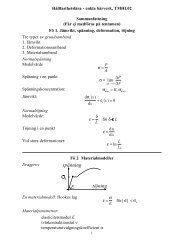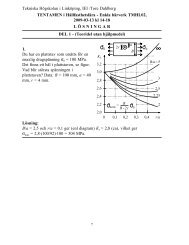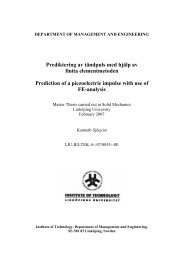FE Assignment C04 - Division of Solid Mechanics
FE Assignment C04 - Division of Solid Mechanics
FE Assignment C04 - Division of Solid Mechanics
Create successful ePaper yourself
Turn your PDF publications into a flip-book with our unique Google optimized e-Paper software.
<strong>FE</strong>M exercises TMHL17 Material <strong>Mechanics</strong><br />
IV. Plasticity: viscoplasticity/creep<br />
1. Overview; background theory<br />
Viscoplasticity is important in applications where high temperature can make time-dependent<br />
deformation develop. Examples are components in gas turbines, aeroengines, steam power plants and<br />
components in high-temperature metal processing plants. To name a further, rather extreme example,<br />
glacier ice creeps, causing the glacier movement that can be recorded by observations over decades <strong>of</strong><br />
years.<br />
The temperature at which time-dependent deformation starts to become important (usually noted )<br />
depends, <strong>of</strong> course, on the material. In stainless steel, is <strong>of</strong> the order <strong>of</strong> 350 °C and in nickel-based<br />
alloys 500 °C.<br />
2. Description <strong>of</strong> problem<br />
Fig. 1 2 stage turbine rotor
Fig. 1 shows a drawing <strong>of</strong> a turbine rotor, consisting <strong>of</strong> two turbine discs mounted together by 8 bolts<br />
(2 <strong>of</strong> which can be seen in the drawing). A conceptual study is to be done in order to investigate if it<br />
would be possible to change the design and replace the 8 bolts with one (larger) centre bolt instead and<br />
if the bolt in that case can be made from the material X22CrMoV12-1.<br />
3. Exercise parts<br />
A <strong>FE</strong> model <strong>of</strong> the geometry has already been set up (see Fig. 2). The Abaqus .inp file containing the<br />
model can be downloaded from the course homepage.<br />
Fig. 2 <strong>FE</strong> model <strong>of</strong> the conceptual centre-bolt design<br />
Tasks<br />
a) Compute the metal temperatures in the turbine rotor during service (steady state). Heat<br />
transfer coefficients and sink temperatures are shown in Fig. 3<br />
b) Make an elastic analysis to compute the stress in the centre bolt in service if the pretension in<br />
the bolt is 60 % <strong>of</strong> R p0.2 at room temperature. Mechanical boundary conditions and materials<br />
are shown in Fig. 4.<br />
c) Compute how much <strong>of</strong> the bolt pretension is left after 30 000 h service (after viscoplastic<br />
relaxation in the bolt).<br />
How much are the contact forces between the discs lowered by the bolt relaxation?
Fig 3 Heat transfer coefficients (HTC) and sink temperatures (T)<br />
Table 1 Rp0.2 for X22CrMoV12-1 according to DIN 17240:1976-07:<br />
Table 2 Relaxation and creep data (DIN 17240:1976-07)
Fig4 Mechanical boundary conditions and materials<br />
Modelling notes<br />
If one assumes that the creep strain can be modelled by a Norton equation<br />
A<br />
B<br />
it can be shown that the relaxed stress after t (h) is:<br />
1<br />
1B<br />
E A<br />
Bt1<br />
B<br />
0<br />
1<br />
,<br />
where E is the elastic modulus and σ 0 is the initial stress. Curve fitting for temperatures up to 460º<br />
gives<br />
B 1.6363e2<br />
2.1087e<br />
1*<br />
T 273.15<br />
6.0093e5<br />
ln( A ) 7.5547e2<br />
<br />
,<br />
T 273.15<br />
<br />
where T is the temperature in ºC. The stress is given in MPa and the time t in h.<br />
(It may happen that a *CREEP routine must be written, since there will be very low values <strong>of</strong> A,<br />
which the standar Abaqus data routines may not accept)



